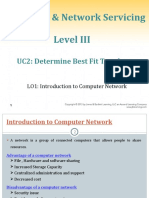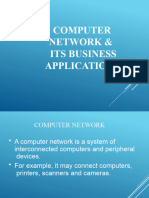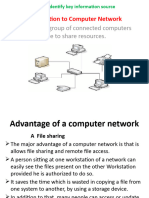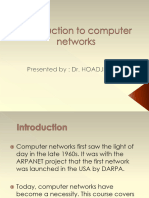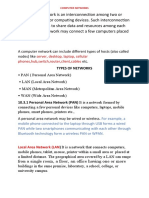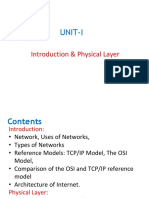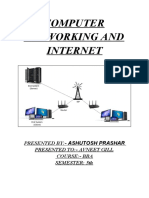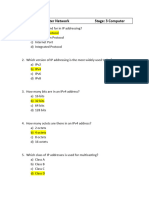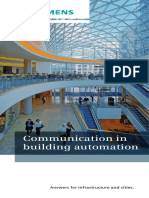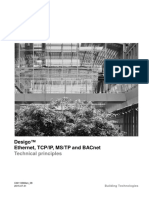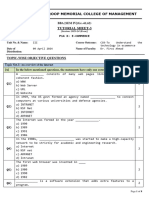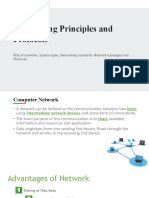Computer Networks Mis Notes
Uploaded by
debanjanbandyopadhyay36Computer Networks Mis Notes
Uploaded by
debanjanbandyopadhyay36lOMoARcPSD|41364308
Computer networks MIS Notes
Human resource management (Mount Kenya University)
Scan to open on Studocu
Studocu is not sponsored or endorsed by any college or university
Downloaded by DIPANJANA BISWAS (dipanjana.biswas@jiscollege.ac.in)
lOMoARcPSD|41364308
Computer networks MIS Notes
A computer network is a communications system connecting two or more computers that
work to exchange information and share resources (hardware, software and data). A network
may consist of microcomputers, or it may integrate microcomputers or other devices with
larger computers. Networks may be controlled by all nodes working together equally or by
specialized nodes coordinating and supplying all resources. Networks may be simple or
complex, self-contained or dispersed over a large geographical area.
Network architecture is a description of how a computer is set-up (configured) and what
strategies are used in the design. The interconnection of PCs over a network is becoming more
important especially as more hardware is accessed remotely and PCs intercommunicate with
each other.
3.1 Terms used to describe computer networks
Node – any device connected to a network such as a computer, printer, or data storage
device.
Client – a node that requests and uses resources available from other nodes. Typically a
microcomputer.
Server – a node that shares resources with other nodes. May be called a file server, printer
server, communication server, web server, or database server.
Network Operating System (NOS) – the operating system of the network that controls and
coordinates the activities between computers on a network, such as electronic
communication and sharing of information and resources.
Distributed processing – computing power is located and shared at different locations.
Common in decentralized organizations (each office has its own computer system but is
networked to the main computer).
Host computer – a large centralized computer, usually a minicomputer or mainframe.
3.2 Types of computer networks
Different communication channels allow different types of networks to be formed. Telephone
lines may connect communications equipment within the same building. Coaxial cable or fiber-
optic cable can be installed on building walls to form communication networks. You can also
create your own network in your home or apartment. Communication networks also differ in
geographical size.
Three important networks according to geographical size are LANs, MANs and WANs.
Local Area Network (LAN)
A LAN is a computer network in which computers and peripheral devices are in close physical
proximity. It is a collection of computers within a single office or building that connect to a
common electronic connection – commonly known as a network backbone. This type of
network typically uses microcomputers in a bus organization linked with telephone, coaxial, or
Downloaded by DIPANJANA BISWAS (dipanjana.biswas@jiscollege.ac.in)
lOMoARcPSD|41364308
fibre-optic cable. A LAN allows all users to share hardware, software and data on the network.
Minicomputers, mainframes or optical disk storage devices can be added to the network. A
network bridge device may be used to link a LAN to other networks with the same
configuration. A network gateway device may be used to link a LAN to other networks, even if
their configurations are different.
Metropolitan Area Network (MAN)
A MAN is a computer network that may be citywide. This type of network may be used as a
link between office buildings in a city. The use of cellular phone systems expand the flexibility
of a MAN network by linking car phones and portable phones to the network.
Wide Area Networks (WAN)
A WAN is a computer network that may be countrywide or worldwide. It normally connects
networks over a large physical area, such as in different buildings, towns or even countries. A
modem connects a LAN to a WAN when the WAN connection is an analogue line.
For a digital connection a gateway connects one type of LAN to another LAN, or WAN, and a
bridge connects a LAN to similar types of LAN. This type of network typically uses microwave
relays and satellites to reach users over long distances. The widest of all WANs is the Internet,
which spans the entire globe.
WAN technologies
How you get from one computer to the other across the Internet.
(i) Circuit switching
A dedicated path between machines is established
All resources are guaranteed
Has limitation of set-up delay but has fast transmission
(ii) Packet switching
Nodes in the network ‘routers’ decide where to send data next
No resources are guaranteed “best effort”
Little set-up, transmission delay at each router
Computer-computer communication
(iii) Frame relay
Like packet switching
Low level error correction removed to yield higher data rates
(iv) Cell relay – ATM (Asynchronous Transmission Mode)
Frame relay with uniformly sized packets (cells)
Dedicated circuit paths
(v) ISDN (Integrated Services Digital Network)
Transmits voice and data traffic
Specialized circuit switching
Uses frame relay (narrowband) and ATM (broadband)
Downloaded by DIPANJANA BISWAS (dipanjana.biswas@jiscollege.ac.in)
lOMoARcPSD|41364308
3.3 Configurations
A computer network configuration is also called its topology. The topology is the method of
arranging and connecting the nodes of a network. There are four principal network topologies:
a) Star
b) Bus
c) Ring
d) Hierarchical (hybrid)
e) Completely connected (mesh)
Star network
In a star network there are a number of small computers or peripheral devices linked to a
central unit called a main hub. The central unit may be a host computer or a file server. All
communications pass through the central unit and control is maintained by polling. This type
of network can be used to provide a time-sharing system and is common for linking
microcomputers to a mainframe.
Advantages:
It is easy to add new and remove nodes
A node failure does not bring down the entire network
It is easier to diagnose network problems through a central hub
Disadvantages:
If the central hub fails the whole network ceases to function
It costs more to cable a star configuration than other topologies (more cable is required
than for a bus or ring configuration).
Node
Bus network
In a bus network each device handles its communications control. There is no host computer;
however there may be a file server. All communications travel along a common connecting
cable called a bus. It is a common arrangement for sharing data stored on different
microcomputers. It is not as efficient as star network for sharing common resources, but is less
expensive. The distinguishing feature is that all devices (nodes) are linked along one
communication line - with endpoints - called the bus or backbone.
Advantages:
Reliable in very small networks as well as easy to use and understand
Downloaded by DIPANJANA BISWAS (dipanjana.biswas@jiscollege.ac.in)
lOMoARcPSD|41364308
Requires the least amount of cable to connect the computers together and therefore is
less expensive than other cabling arrangements.
Is easy to extend. Two cables can be easily joined with a connector, making a longer
cable for more computers to join the network
A repeater can also be used to extend a bus configuration
Disadvantages:
Heavy network traffic can also slow a bus considerably. Because any computer can
transmit at any time, bus networks do not coordinate when information is sent.
Computers interrupting each other can use a lot of bandwidth
Each connection between two cables weakens the electrical signal
The bus configuration can be difficult to troubleshoot. A cable break or malfunctioning
computer can be difficult to find and can cause the whole network to stop functioning.
Ring network
In a ring network each device is connected to two other devices, forming a ring. There is no
central file server or computer. Messages are passed around the ring until they reach their
destination. Often used to link mainframes, especially over wide geographical areas. It is useful
in a decentralized organization called a distributed data processing system.
Advantages:
Ring networks offer high performance for a small number of workstations or for larger
networks where each station has a similar work load
Ring networks can span longer distances than other types of networks
Ring networks are easily extendable
Disadvantages
Relatively expensive and difficult to install
Failure of one component on the network can affect the whole network
Downloaded by DIPANJANA BISWAS (dipanjana.biswas@jiscollege.ac.in)
lOMoARcPSD|41364308
It is difficult to troubleshoot a ring network
Adding or removing computers can disrupt the network
Hierarchical (hybrid) network
A hierarchical network consists of several computers linked to a central host computer. It is
similar to a star. Other computers are also hosts to other, smaller computers or to peripheral
devices in this type of network. It allows various computers to share databases, processing
power, and different output devices. It is useful in centralized organizations.
Advantages:
Improves sharing of data and programs across the network
Offers reliable communication between nodes
Disadvantages:
Difficult and costly to install and maintain
Difficult to troubleshoot network problems
Completely connected (mesh) configuration
Is a network topology in which devices are connected with many redundant interconnections
between network nodes.
Advantages:
Yields the greatest amount of redundancy (multiple connections between same nodes)
in the event that one of the nodes fail where network traffic can be redirected to another
node.
Network problems are easier to diagnose
Disadvantages
The cost of installation and maintenance is high (more cable is required than any other
configuration)
Downloaded by DIPANJANA BISWAS (dipanjana.biswas@jiscollege.ac.in)
lOMoARcPSD|41364308
3.4 Client/Server environment
Use of client/server technology is one of the most popular trends in application development.
More and more business applications have embraced the advantages of the client/server
architecture by distributing the work among servers and by performing as much
computational work as possible on the client workstation. This allows users to manipulate and
change the data that they need to change without controlling resources on the main processing
unit.
In client/server systems, applications no longer are limited to running on one machine. The
applications are split so that processing may take place on different machines. The processing
of data takes place on the server and the desktop computer (client). The application is divided
into pieces or tasks so processing can be done more efficiently.
A client/server network environment is one in which one computer acts as the server and
provides data distribution and security functions to other computers that are independently
running various applications. An example of the simplest client/server model is a LAN
whereby a set of computers is linked to allow individuals to share data. LANs (like other
client/server environments) allow users to maintain individual control over how information
is processed.
Client/server computing differs from mainframe or distributed system processing in that each
processing component is mutually dependent. The ‘client’ is a single PC or workstation
associated with software that provides computer presentation services as an interface to server
computing resources. Presentation is usually provided by visually enhanced processing
software known as a Graphical User Interface (GUI). The ‘server’ is one or more multi-user
computer(s) (these may be mainframes, minicomputers or PCs). Server functions include any
centrally supported role, such as file sharing, printer sharing, database access and
management, communication services, facsimile services, application development and others.
Multiple functions may be supported by a single server.
3.5 Network protocols
Protocols are the set of conventions or rules for interaction at all levels of data transfer. They
have three main components:
Syntax – data format and signal types
Semantics – control information and error handling
Timing – data flow rate and sequencing
Numerous protocols are involved in transferring a single file even when two computers are
directly connected. The large task of transferring a piece of data is broken down into distinct
sub tasks. There are multiple ways to accomplish each task (individual protocols). The tasks are
well described so that they can be used interchangeably without affecting the overall system.
Downloaded by DIPANJANA BISWAS (dipanjana.biswas@jiscollege.ac.in)
lOMoARcPSD|41364308
Benefits derived from using network protocols include:
Smaller user applications – the browser runs HTTP (Hyper Text Transfer Protocol). It
isn’t aware of how the connection to the network is made.
Can take advantage of new technologies – one can browse on a wireless palm or cell
phone
Don’t have to reinvent the wheel – fewer programming errors, less effort during
development of network-oriented application systems as previous components are
reused.
Enhanced uniformity in communication
Common network protocols include:
(i) 3 layer logical model
(ii) TCP/IP (Transmission Control Protocol/Internet Protocol)
(iii) ISO/OSI model (International Organizations for Standards/Open System
Interconnection)
Three (3) layer logical model
Application Layer
o Takes care of the needs of the specific application
o HTTP: send request, get a batch of responses from a bunch of different servers
o Telnet: dedicated interaction with another machine
Transport Layer
o Makes sure data is exchanged reliably between the two end systems
o Needs to know how to identify the remote system and package the data properly
Network Access Layer
o Makes sure data is exchanged reliably into and out of the computer.
o Concerns the physical connection to the network and transfer of information across
this connection
o Software here depends on physical medium used
TCP/IP (Transmission Control Protocol/Internet Protocol)
Application Layer
o User application protocols
Transport Layer
o Transmission control protocol
o Data reliability and sequencing
Internet Layer
o Internet Protocol
o Addressing, routing data across Internet
Network Access Layer
o Data exchange between host and local network
o Packets, flow control
o Network dependent (circuit switching, Ethernet etc)
Downloaded by DIPANJANA BISWAS (dipanjana.biswas@jiscollege.ac.in)
lOMoARcPSD|41364308
Physical Layer
o Physical interface, signal type, data rate
ISO/OSI Model (International Standard Organization/Open System Interconnection)
An important concept in understanding data communications is the Open Systems
Interconnection (OSI) model. It allows manufacturers of different systems to interconnect their
equipment through standard interfaces. It also allows software and hardware to integrate well
and be portable on differing systems. The International Standards Organization (ISO)
developed the model.
Data is passed from top layer of the transmitter to the bottom, then up from the bottom layer to
the top on the recipient. However, each layer on the transmitter communicates directly with
the recipient’s corresponding layer. This creates a virtual data flow between layers. The data
sent can be termed as a data packet or data frame.
Data Data
Virtual Data Flow
Application Application
Presentation Presentation
Session Session
Transport Transport
Network Network
Data Link Data Link
Physical Physical
Transmitter Actual Data Flow Recipient
1. Application Layer
This layer provides network services to application programs such as file transfer and
electronic mail. It offers user level interaction with network programs and provides user
application, process and management functions.
2. Presentation Layer
The presentation layer uses a set of translations that allow the data to be interpreted properly.
It may have to carry out translations between two systems if they use different presentation
standards such as different character sets or different character codes. It can also add data
encryption for security purposes. It basically performs data interpretation, format and control
transformation. It separates what is communicated from data representation.
3. Session Layer
The session layer provides an open communications path to the other system. It involves
setting up, maintaining and closing down a session (a communication time span). The
Downloaded by DIPANJANA BISWAS (dipanjana.biswas@jiscollege.ac.in)
lOMoARcPSD|41364308
communications channel and the internetworking should be transparent to the session layer. It
manages (administration and control) sessions between cooperating applications.
4. Transport Layer
If data packets require to go out of a network then the transport layer routes them through the
interconnected networks. Its task may involve splitting up data for transmission and
reassembling it after arrival. It performs the tasks of end-to-end packetization, error control,
flow control, and synchronization. It offers network transparent data transfer and transmission
control.
5. Network Layer
The network layer routes data frames through a network. It performs the tasks of connection
management, routing, switching and flow control over a network.
6. Data Link Layer
The data link layer ensures that the transmitted bits are received in a reliable way. This
includes adding bits to define the start and end of a data frame, adding extra error
detection/correction bits and ensuring that multiple nodes do not try to access a common
communications channel at the same time. It has the tasks of maintaining and releasing the
data link, synchronization, error and flow control.
7. Physical Layer
The physical link layer defines the electrical characteristics of the communications channel and
the transmitted signals. This includes voltage levels, connector types, cabling, data rate etc. It
provides the physical interface.
3.6 Network cable types
The cable type used on a network depends on several parameters including:
The data bit rate
The reliability of the cable
The maximum length between nodes
The possibility of electrical hazards
Power loss in cables
Tolerance or harsh conditions
Expense and general availability of the cache
Ease of connection and maintenance
Ease of running cables
The main types of cables used in networks are twisted-pair, coaxial and fibre-optic. Twisted-
pair and coaxial cables transmit electric signals, whereas fibre-optic cables transmit light
pulses. Twisted-pair cables are not shielded and thus interfere with nearby cables. Public
telephone lines generally use twisted-pair cables. In LANs they are generally used up to bit
rates of 10 Mbps and with maximum lengths of 100m.
Downloaded by DIPANJANA BISWAS (dipanjana.biswas@jiscollege.ac.in)
lOMoARcPSD|41364308
Coaxial cable has a grounded metal sheath around the signal conductor. This limits the amount
of interference between cables and thus allows higher data rates. Typically they are used at bit
rates of 100 Mbps for maximum lengths of 1 km.
The highest specification of the three cables is fibre-optic. This type of cable allows extremely
high bit rates over long distances. Fibre-optic cables do not interfere with nearby cables and
give greater security, more protection from electrical damage by external equipment and
greater resistance to harsh environments; they are also safer in hazardous environments.
3.7 Internetworking connections
Most modern networks have a backbone, which is a common link to all the networks within an
organization. This backbone allows users on different network segments to communicate and
also allows data into and out of the local network.
Networks are partitioned from other networks using a bridge, a gateway or a router. A bridge
links two networks of the same type. A gateway connects two networks of dissimilar type.
Routers operate rather like gateways and can either connect two similar networks or two
dissimilar networks. The key operation of a gateway, bridge or router is that it only allows data
traffic through itself when the data is intended for another network which is outside the
connected network. This filters traffic and stops traffic not intended for the network from
clogging up the backbone. Modern bridges, gateways and routers are intelligent and can
determine the network topology. A spanning-tree bridge allows multiple network segments to
be interconnected. If more than one path exists between individual segments then the bridge
finds alternative routes. This is useful in routing frames away from heavy traffic routes or
around a faulty route.
A repeater is used to increase the maximum interconnection length since for a given cable
specification and bit rate, each has a maximum length of cable.
3.8 Network Standards
Standards are good because they allow many different implementations of interoperable
technology. However they are slow to develop and multiple standard organizations develop
different standards for the same functions.
3.9 Application of computer networks within an organization
Connectivity is the ability and means to connect a microcomputer by telephone or other
telecommunication links to other computers and information sources around the world.
The connectivity options that make communication available to end-users include:
Fax machines (Facsimile transmission machines).
E-mail (Electronic mail)
Voice messaging systems
Video conferencing systems
Downloaded by DIPANJANA BISWAS (dipanjana.biswas@jiscollege.ac.in)
lOMoARcPSD|41364308
Shared resources
Online services
Fax machines
Fax machines convert images to signals that can be sent over a telephone line to a receiving
machine. They are extremely popular in offices. They can scan the image of a document and
print the image on paper. Microcomputers use fax/modem circuit boards to send and receive
fax messages.
E-mail (electronic mail)
E-mail is a method of sending an electronic message between individuals or computers. One
can receive e-mail messages even when one is not on the computer. E-mail messages can
contain text, graphics, images as well as sound.
Voice messaging systems
Voice messaging systems are computer systems linked to telephones that convert human voice
into digital bits. They resemble conventional answering machines and electronic mail systems.
They can receive large numbers of incoming calls and route them to appropriate ‘voice
mailboxes’ which are recorded voice messages. They can forward calls and deliver the same
message to many people.
Video conferencing systems
Video conferencing systems are computer systems that allow people located at various
geographic locations to have in-person meetings. They can use specially equipped
videoconferencing rooms to hold meetings. Desktop videoconferencing systems use
microcomputers equipped with inexpensive video cameras and microphones that sit atop a
computer monitor.
Shared resources
Shared resources are communication networks that permit microcomputers to share expensive
hardware such as laser printers, chain printers, disk packs and magnetic tape storage. Several
microcomputers linked in a network make shared resources possible. The connectivity
capabilities of shared resources provide the ability to share data located on a computer.
Online services
Downloaded by DIPANJANA BISWAS (dipanjana.biswas@jiscollege.ac.in)
lOMoARcPSD|41364308
Online services are business services offered specifically for microcomputer users. Well-known
online service providers are America Online (AOL), AT&T WorldNet, CompuServe, Africa
Online, Kenyaweb, UUNET, Wananchi Online and Microsoft Network. Typical online services
offered by these providers are:
Teleshopping- a database which lists prices and description of products. You place an order,
charge the purchase to a credit card and merchandise is delivered by a delivery service.
Home banking – banks offer this service so you can use your microcomputer to pay bills, make
loan payments, or transfer money between accounts.
Investing – investment firms offer this service so you can access current prices of stocks and
bonds. You can also buy and sell orders.
Travel reservations – travel organizations offer this service so you can get information on
airline schedules and fare, order tickets, and charge to a credit card.
Internet access – you can get access to the World Wide Web.
Internet
The Internet is a giant worldwide network. The Internet started in 1969 when the United States
government funded a major research project on computer networking called ARPANET
(Advanced Research Project Agency NETwork). When on the Internet you move through
cyberspace.
Cyberspace is the space of electronic movement of ideas and information.
The web provides a multimedia interface to resources available on the Internet. It is also
known as WWW or World Wide Web. The web was first introduced in 1992 at CERN (Centre
for European Nuclear Research) in Switzerland. Prior to the web, the Internet was all text with
no graphics, animations, sound or video.
Common Internet applications
Communicating
o Communicating on the Internet includes e-mail, discussion groups (newsgroups),
and chat groups
o You can use e-mail to send or receive messages to people around the world
o You can join discussion groups or chat groups on various topics
Shopping
Downloaded by DIPANJANA BISWAS (dipanjana.biswas@jiscollege.ac.in)
lOMoARcPSD|41364308
- Shopping on the Internet is called e-commerce
- You can window shop at cyber malls called web storefronts
- You can purchase goods using checks, credit cards or electronic cash called
electronic payment
Researching
- You can do research on the Internet by visiting virtual libraries and browse
through stacks of books
- You can read selected items at the virtual libraries and even check out books
Entertainment
- There are many entertainment sites on the Internet such as live concerts, movie
previews and book clubs
- You can also participate in interactive live games on the Internet
How do you get connected to the Internet?
You get connected to the Internet through a computer. Connection to the Internet is referred to
as access to the Internet. Using a provider is one of the most common ways users can access the
Internet. A provider is also called a host computer and is already connected to the Internet. A
provider provides a path or connection for individuals to access the Internet.
There are three widely used providers:
(i) Colleges and universities – colleges and universities provide free access to the Internet
through their Local Area Networks,
(ii) Internet Service Providers (ISP) – ISPs offer access to the Internet for a fee. They are
more expensive than online service providers.
(iii) Online Service Providers – provide access to the Internet and a variety of other services
for a fee. They are the most widely used source for Internet access and less expensive
than ISP.
Connections
There are three types of connections to the Internet through a provider:
o Direct or dedicated
o SLIP and PPP
o Terminal connection
Direct or dedicated
This is the most efficient access method to all functions on the Internet. However it is expensive
and rarely used by individuals. It is used by many organizations such as colleges, universities,
service providers and corporations.
SLIP and PPP
This type of connection is widely used by end users to connect to the Internet. It is slower and
less convenient than direct connection. However it provides a high level of service at a lower
cost than direct connection. It uses a high-speed modem and standard telephone line to connect
to a provider that has a direct connection to the Internet. It requires special software protocol:
Downloaded by DIPANJANA BISWAS (dipanjana.biswas@jiscollege.ac.in)
lOMoARcPSD|41364308
SLIP (Serial Line Internet Protocol) or PPP (Point-to-Point Protocol). With this type of
connection your computer becomes part of a client/server network. It requires special client
software to communicate with server software running on the provider’s computer and other
Internet computers.
Terminal connection
This type of connection also uses a high-speed modem and standard telephone line. Your
computer becomes part of a terminal network with a terminal connection. With this
connection, your computer’s operations are very limited because it only displays
communication that occurs between provider and other computers on the Internet. It is less
expensive than SLIP or PPP but not as fast or convenient.
Internet protocols
TCP/IP
The standard protocol for the Internet is TCP/IP. TCP/IP (Transmission Control
Protocol/Internet Protocol) are the rules for communicating over the Internet. Protocols control
how the messages are broken down, sent and reassembled. With TCP/IP, a message is broken
down into small parts called packets before it is sent over the Internet. Each packet is sent
separately, possibly travelling through different routes to a common destination. The packets
are reassembled into correct order at the receiving computer.
Internet services
The four commonly used services on the Internet are:
Telnet
FTP
Gopher
The Web
Telnet
Telnet allows you to connect to another computer (host) on the Internet
With Telnet you can log on to the computer as if you were a terminal connected to it
There are hundreds of computers on the Internet you can connect to
Some computers allow free access; some charge a fee for their use
FTP (File Transfer Protocol)
FTP allows you to copy files on the Internet
If you copy a file from an Internet computer to your computer, it is called downloading.
If you copy a file from your computer to an Internet computer, it is called uploading.
Downloaded by DIPANJANA BISWAS (dipanjana.biswas@jiscollege.ac.in)
lOMoARcPSD|41364308
Gopher
Gopher allows you to search and retrieve information at a particular computer site
called a gopher site
Gopher is a software application that provides menu-based functions for the site.
It was originally developed at the University of Minnesota in 1991
Gopher sites are computers that provide direct links to available resources, which may
be on other computers
Gopher sites can also handle FTP and Telnet to complete their retrieval functions
The Web
The web is a multimedia interface to resources available on the Internet
It connects computers and resources throughout the world
It should not be confused with the term Internet
Browser
A browser is a special software used on a computer to access the web
The software provides an uncomplicated interface to the Internet and web documents
It can be used to connect you to remote computers using Telnet
It can be used to open and transfer files using FTP
It can be used to display text and images using the web
Two well-known browsers are:
o Netscape communicator
o Microsoft Internet Explorer
Uniform Resource Locators (URLs)
URLs are addresses used by browsers to connect to other resources
URLs have at least two basic parts
o Protocol – used to connect to the resource, HTTP (Hyper Text Transfer Protocol)
is the most common.
o Domain Name – the name of the server where the resource is located
Many URLs have additional parts specifying directory paths, file names and pointers
Connecting to a URL means that you are connecting to another location called a web
site
Moving from one web site to another is called surfing
Web portals
Downloaded by DIPANJANA BISWAS (dipanjana.biswas@jiscollege.ac.in)
lOMoARcPSD|41364308
Web portals are sites that offer a variety of services typically including e-mail, sports updates,
financial data, news and links to selected websites. They are designed to encourage you to visit
them each time you access the web. They act as your home base and as a gateway to their
resources
Web pages
A web page is a document file sent to your computer when the browser has connected to a
website. The document file may be located on a local computer or halfway around the world.
The document file is formatted and displayed on your screen as a web page through the
interpretation of special command codes embedded in the document called HTML (Hyper Text
Mark-up Language).
Typically the first web page on a website is referred to as the home page. The home page
presents information about the site and may contain references and connections to other
documents or sites called hyperlinks. Hyperlink connections may contain text files, graphic
images, audio and video clips. Hyperlink connections can be accessed by clicking on the
hyperlink.
Applets and Java
Web pages contain links to special programs called applets written in a programming
language called Java.
Java applets are widely used to add interest and activity to a website.
Applets can provide animation, graphics, interactive games and more.
Applets can be downloaded and run by most browsers.
Search tools
Search tools developed for the Internet help users locate precise information. To access a search
tool, you must visit a web site that has a search tool available. There are two basic types of
search tools available:
- Indexes
- Search engines
Indexes
Indexes are also known as web directories
They are organized by major categories e.g. Health, entertainment, education etc
Each category is further organized into sub categories
Users can continue to search of subcategories until a list of relevant documents appear
The best known search index is Yahoo
Downloaded by DIPANJANA BISWAS (dipanjana.biswas@jiscollege.ac.in)
lOMoARcPSD|41364308
Search engines
Search engines are also known as web crawlers or web spiders
They are organized like a database
Key words and phrases can be used to search through a database
Databases are maintained by special programs called agents, spiders or bots
Widely used search engines are Google, HotBot and AltaVista.
Web utilities
Web utilities are programs that work with a browser to increase your speed, productivity and
capabilities. These utilities can be included in a browser. Some utilities may be free on the
Internet while others can be charged for a nominal charge. There are two categories of web
utilities:
Plug-ins
Helper applications
Plug-ins
A plug-in is a program that automatically loads and operates as part of your browser.
Many websites require plug-ins for users to fully experience web page contents
Some widely used plug-ins are:
o Shockwave from macromedia – used for web-based games, live concerts and
dynamic animations
o QuickTime from Apple – used to display video and play audio
o Live-3D from Netscape – used to display three-dimensional graphics and virtual
reality
Helper applications
Helper applications are also known as add-ons and helper applications. They are independent
programs that can be executed or launched from your browser. The four most common types
of helper applications are:
Off-line browsers – also known as web-downloading utilities and pull products. It is a
program that automatically connects you to selected websites. They download HTML
documents and saves them to your hard disk. The document can be read latter without
being connected to the Internet.
Information pushers – also known as web broadcasters or push products. They
automatically gather information on topic areas called channels. The topics are then
Downloaded by DIPANJANA BISWAS (dipanjana.biswas@jiscollege.ac.in)
lOMoARcPSD|41364308
sent to your hard disk. The information can be read later without being connected to
the Internet.
Metasearch utilities – offline search utilities are also known as metasearch programs.
They automatically submit search requests to several indices and search engines. They
receive the results, sort them, eliminate duplicates and create an index.
Filters – filters are programs that allow parents or organizations to block out selected
sites e.g. adult sites. They can monitor the usage and generate reports detailing time
spent on activities.
Discussion groups
There are several types of discussion groups on the Internet:
Mailing lists
Newsgroups
Chat groups
Mailing lists
In this type of discussion groups, members communicate by sending messages to a list address.
To join, you send your e-mail request to the mailing list subscription address. To cancel, send
your email request to unsubscribe to the subscription address.
Newsgroups
Newsgroups are the most popular type of discussion group. They use a special type of
computers called UseNet. Each UseNet computer maintains the newsgroup listing. There are
over 10,000 different newsgroups organized into major topic areas. Newsgroup organization
hierarchy system is similar to the domain name system. Contributions to a particular
newsgroup are sent to one of the UseNet computers. UseNet computers save messages and
periodically share them with other UseNet computers. Interested individuals can read
contributions to a newsgroup.
Chat groups
Chat groups are becoming a very popular type of discussion group. They allow direct ‘live’
communication (real time communication). To participate in a chat group, you need to join by
selecting a channel or a topic. You communicate live with others by typing words on your
computer. Other members of your channel immediately see the words on their computers and
they can respond. The most popular chat service is called Internet Relay Chat (IRC), which
requires special chat client software.
Instant messaging
Instant messaging is a tool to communicate and collaborate with others. It allows one or more
people to communicate with direct ‘live’ communication. It is similar to chat groups, but it
provides greater control and flexibility. To use instant messaging, you specify a list of friends
(buddies) and register with an instant messaging server e.g. Yahoo Messenger. Whenever you
connect to the Internet, special software will notify your messaging server that you are online.
Downloaded by DIPANJANA BISWAS (dipanjana.biswas@jiscollege.ac.in)
lOMoARcPSD|41364308
It will notify you if any of your friends are online and will also notify your buddies that you
are online.
E-mail (Electronic Mail)
E-mail is the most common Internet activity. It allows you to send messages to anyone in the
world who has an Internet e-mail account. You need access to the Internet and e-mail program
to use this type of communication. Two widely used e-mail programs are Microsoft’s Outlook
Express and Netscape’s Communicator.
E-mail has three basic elements:
(i) Header – appears first in an e-mail message and contains the following information
a. Address – the address of the person(s) that is to receive the e-mail
b. Subject – a one line description of the message displayed when a person checks
their mail
c. Attachment – files that can be sent by the e-mail program
(ii) Message – the text of the e-mail communication
(iii) Signature – may include sender’s name, address and telephone number (optional)
E-mail addresses
The most important element of an e-mail message is the address of the person who is to receive
the letter. The Internet uses an addressing method known as the Domain Name System (DNS).
The system divides an address into three parts:
(i) User name – identifies a unique person or computer at the listed domain
(ii) Domain name – refers to a particular organization
(iii) Domain code – identifies the geographical or organizational area
Almost all ISPs and online service providers offer e-mail service to their customers.
The main advantages of email are:
It is normally much cheaper than using the telephone (although, as time equates to
money for most companies, this relates any savings or costs to a user’s typing speed).
Many different types of data can be transmitted, such as images, documents, speech etc.
It is much faster than the postal service.
Users can filter incoming email easier than incoming telephone calls.
It normally cuts out the need for work to be typed, edited and printed by a secretary.
It reduces the burden on the mailroom
It is normally more secure than traditional methods
It is relatively easy to send to groups of people (traditionally, either a circulation list
was required or a copy to everyone in the group was required).
It is usually possible to determine whether the recipient has actually read the message
(the electronic mail system sends back an acknowledgement).
The main disadvantages are:
It stops people using the telephone
It cannot be used as a legal document
Downloaded by DIPANJANA BISWAS (dipanjana.biswas@jiscollege.ac.in)
lOMoARcPSD|41364308
Electronic mail messages can be sent on the spur of the moment and may be regretted
later on (sending by traditional methods normally allows for a rethink). In extreme
cases messages can be sent to the wrong person (typically when replying to an email
message, where messages is sent to the mailing list rather than the originator).
It may be difficult to send to some remote sites. Many organizations have either no
electronic mail or merely an intranet. Large companies are particularly wary of Internet
connections and limit the amount of external traffic.
Not everyone reads his or her electronic mail on a regular basis (although this is
changing as more organizations adopt email as the standard communication medium).
The main standards that relate to the protocols of email transmission and reception are:
Simple Mail Transfer Protocol (SMTP) – which is used with the TCP/IP suite. It has
traditionally been limited to the text-based electronic messages.
Multipurpose Internet Mail Extension – which allows the transmission and reception
of mail that contains various types of data, such as speech, images and motion video. It
is a newer standard than SMTP and uses much of its basic protocol.
Organizational Internets: Intranets and Extranets
An organization may experience two disadvantages in having a connection to the WWW and
the Internet:
The possible use of the Internet for non-useful applications (by employees).
The possible connection of non-friendly users from the global connection into the
organization’s local network.
For these reasons, many organizations have shied away from connection to the global network
and have set-up intranets and extranets.
An organizational Internet is the application of Internet technologies within a business
network. It is used to connect employees to each other and to other organizations. There are
two types of technologies used in organizational Internets:
o Intranets – a private network within an organization
o Extranets – a private network that connects more than one organization
Firewalls are often used to protect organizational Internets from external threats.
Intranets
Intranets are in-house, tailor-made networks for use within the organization and provide
limited access (if any) to outside services and also limit the external traffic (if any) into the
intranet. An intranet might have access to the Internet but there will be no access from the
Internet to the organization’s intranet.
Organizations which have a requirement for sharing and distributing electronic information
normally have three choices:
- Use a proprietary groupware package such as Lotus Notes
- Set up an Intranet
Downloaded by DIPANJANA BISWAS (dipanjana.biswas@jiscollege.ac.in)
lOMoARcPSD|41364308
- Set up a connection to the Internet
Groupware packages normally replicate data locally on a computer whereas Intranets
centralize their information on central servers which are then accessed by a single browser
package. The stored data is normally open and can be viewed by any compatible WWW
browser. Intranet browsers have the great advantage over groupware packages in that they are
available for a variety of clients, such as PCs, Macs, UNIX workstations and so on. A client
browser also provides a single GUI interface, which offers easy integration with other
applications such as electronic mail, images, audio, video, animation and so on.
The main elements of an Intranet are:
Intranet server hardware
Intranet server software
TCP/IP stack software on the clients and servers
WWW browsers
A firewall
Other properties defining an Intranet are:
Intranets use browsers, websites, and web pages to resemble the Internet within the
business.
They typically provide internal e-mail, mailing lists, newsgroups and FTP services
These services are accessible only to those within the organization
Extranets
Extranets (external Intranets) allow two or more companies to share parts of their Intranets
related to joint projects. For example two companies may be working on a common project, an
Extranet would allow them to share files related with the project.
Extranets allow other organizations, such as suppliers, limited access to the
organization’s network.
The purpose of the extranet is to increase efficiency within the business and to reduce
costs
Firewalls
A firewall (or security gateway) is a security system designed to protect organizational
networks. It protects a network against intrusion from outside sources. They may be
categorized as those that block traffic or those that permit traffic.
It consists of hardware and software that control access to a company’s intranet,
extranet and other internal networks.
It includes a special computer called a proxy server, which acts as a gatekeeper.
All communications between the company’s internal networks and outside world must
pass through this special computer.
The proxy server decides whether to allow a particular message or file to pass through.
4. Information superhighway
Downloaded by DIPANJANA BISWAS (dipanjana.biswas@jiscollege.ac.in)
lOMoARcPSD|41364308
Information superhighway is a name first used by US Vice President Al Gore for the vision of a
global, high-speed communications network that will carry voice, data, video and other forms
of information all over the world, and that will make it possible for people to send e-mail, get
up-to-the-minute news, and access business, government and educational information. The
Internet is already providing many of these features, via telephone networks, cable TV services,
online service providers and satellites.
It is commonly used as a synonym for National Information Infrastructure (NII). NII is
a proposed, advanced, seamless web of public and private communications networks,
interactive services, interoperable hardware and software, computers, databases, and
consumer electronics to put vast amounts of information at user’s fingertips.
5. Terminology
Multiplexors/concentrators
Are the devices that use several communication channels at the same time. A multiplexor
allows a physical circuit to carry more than one signal at one time when the circuit has more
capacity (bandwidth) than individual signals required. It transmits and receives messages and
controls the communication lines to allow multiple users access to the system. It can also link
several low-speed lines to one high-speed line to enhance transmission capabilities.
Front end communication processors
Are the hardware devices that connect all network communication lines to a central computer
to relieve the central computer from performing network control, format conversion and
message handling tasks. Other functions that a front-end communication processor performs
are:
o Polling and addressing of remote units
o Dialling and answering stations on a switched network
o Determining which remote station a block is to be sent
o Character code translation
o Control character recognition and error checking
o Error recovery and diagnostics
o Activating and deactivating communication lines
Cluster controllers
Are the communications terminal control units that control a number of devices such as
terminals, printers and auxiliary storage devices. In such a configuration devices share a
common control unit, which manages input/output operations with a central computer. All
messages are buffered by the terminal control unit and then transmitted to the receivers.
Protocol converters
Are devices used to convert from one protocol to another such as between asynchronous and
synchronous transmission. Asynchronous terminals are attached to host computers or host
communication controllers using protocol converters. Asynchronous communication
techniques do not allow easy identification of transmission errors; therefore, slow transmission
Downloaded by DIPANJANA BISWAS (dipanjana.biswas@jiscollege.ac.in)
lOMoARcPSD|41364308
speeds are used to minimize the potential for errors. It is desirable to communicate with the
host computer using synchronous transmission if high transmission speeds or rapid response
is needed.
Multiplexing
Multiplexing is sending multiple signals or streams of information on a carrier at the same time
in the form of a single, complex signal and then recovering the separate signals at the receiving
end. Analog signals are commonly multiplexed using frequency-division multiplexing (FDM),
in which the carrier bandwidth is divided into sub-channels of different frequency widths, each
carrying a signal at the same time in parallel. Digital signals are commonly multiplexed using
time-division multiplexing (TDM), in which the multiple signals are carried over the same
channel in alternating time slots. In some optical fiber networks, multiple signals are carried
together as separate wavelengths of light in a multiplexed signal using dense wavelength
division multiplexing (DWDM).
Circuit-switched
Circuit-switched is a type of network in which a physical path is obtained for and dedicated to
a single connection between two end-points in the network for the duration of the connection.
Ordinary voice phone service is circuit-switched. The telephone company reserves a specific
physical path to the number you are calling for the duration of your call. During that time, no
one else can use the physical lines involved.
Circuit-switched is often contrasted with packet-switched. Some packet-switched networks
such as the X.25 network are able to have virtual circuit-switching. A virtual circuit-switched
connection is a dedicated logical connection that allows sharing of the physical path among
multiple virtual circuit connections.
Packet-switched
Packet-switched describes the type of network in which relatively small units of data called
packets are routed through a network based on the destination address contained within each
packet. Breaking communication down into packets allows the same data path to be shared
among many users in the network. This type of communication between sender and receiver is
known as connectionless (rather than dedicated). Most traffic over the Internet uses packet
switching and the Internet is basically a connectionless network.
Virtual circuit
A virtual circuit is a circuit or path between points in a network that appears to be a discrete,
physical path but is actually a managed pool of circuit resources from which specific circuits
are allocated as needed to meet traffic requirements.
A permanent virtual circuit (PVC) is a virtual circuit that is permanently available to the user
just as though it were a dedicated or leased line continuously reserved for that user. A
switched virtual circuit (SVC) is a virtual circuit in which a connection session is set up for a
user only for the duration of a connection. PVCs are an important feature of frame relay
networks and SVCs are proposed for later inclusion.
Closed circuit television
Downloaded by DIPANJANA BISWAS (dipanjana.biswas@jiscollege.ac.in)
lOMoARcPSD|41364308
Closed circuit television (CCTV) is a television system in which signals are not publicly
distributed; cameras are connected to television monitors in a limited area such as a store, an
office building, or on a college campus. CCTV is commonly used in surveillance systems.
VSAT
VSAT (Very Small Aperture Terminal) is a satellite communications system that serves home
and business users. A VSAT end user needs a box that interfaces between the user's computer
and an outside antenna with a transceiver. The transceiver receives or sends a signal to a
satellite transponder in the sky. The satellite sends and receives signals from an earth station
computer that acts as a hub for the system. Each end user is interconnected with the hub
station via the satellite in a star topology. For one end user to communicate with another, each
transmission has to first go to the hub station which retransmits it via the satellite to the other
end user's VSAT. VSAT handles data, voice, and video signals.
VSAT offers a number of advantages over terrestrial alternatives. For private applications,
companies can have total control of their own communication system without dependence on
other companies. Business and home users also get higher speed reception than if using
ordinary telephone service or ISDN.
Downloaded by DIPANJANA BISWAS (dipanjana.biswas@jiscollege.ac.in)
You might also like
- Topic 3 Introduction To Computer NetworksNo ratings yetTopic 3 Introduction To Computer Networks12 pages
- Networking: Two Types of Networking ConfigurationNo ratings yetNetworking: Two Types of Networking Configuration8 pages
- Introduction To Computer Network: A Network Is A Group of Connected Computers That Allows People To Share ResourcesNo ratings yetIntroduction To Computer Network: A Network Is A Group of Connected Computers That Allows People To Share Resources53 pages
- Chapter Two: Introduction To Computer NetworksNo ratings yetChapter Two: Introduction To Computer Networks47 pages
- Lecture 12 - Introduction To Computer NetworksNo ratings yetLecture 12 - Introduction To Computer Networks43 pages
- Unit 3: Networks: - Karishma Verma Institute of Hotel Management, BangaloreNo ratings yetUnit 3: Networks: - Karishma Verma Institute of Hotel Management, Bangalore32 pages
- STD VII - Lesson 1 - Computer Networking.No ratings yetSTD VII - Lesson 1 - Computer Networking.11 pages
- The Internet Is A Global System of Interconnected Computer Networks That Use The Standard Internet Protocol SuiteNo ratings yetThe Internet Is A Global System of Interconnected Computer Networks That Use The Standard Internet Protocol Suite4 pages
- Network Application Sensitivity AnalysisNo ratings yetNetwork Application Sensitivity Analysis7 pages
- Basics of Internet, Intranet, E-Mail, Audio and Video-Conferencing (ICT)No ratings yetBasics of Internet, Intranet, E-Mail, Audio and Video-Conferencing (ICT)5 pages
- Reaction Paper On Cyberspace Regulation - Mr. SucgangNo ratings yetReaction Paper On Cyberspace Regulation - Mr. Sucgang3 pages
- Computer Hardware Servicing Grade 10 - Module 1 Personal Entrepreneurial Competencies (Pecs) Teachers GuideNo ratings yetComputer Hardware Servicing Grade 10 - Module 1 Personal Entrepreneurial Competencies (Pecs) Teachers Guide111 pages
- cs601 Quiz 1 Searching File by Msa Vu ServicesNo ratings yetcs601 Quiz 1 Searching File by Msa Vu Services37 pages
- Desigo™ Ethernet, Tcp/Ip, MS/TP and Bacnet: Technical PrinciplesNo ratings yetDesigo™ Ethernet, Tcp/Ip, MS/TP and Bacnet: Technical Principles72 pages
- Shivam Gupta - 1171788818 - Project ReportNo ratings yetShivam Gupta - 1171788818 - Project Report74 pages
- (Laurence King) Alan Pipes - How To Design Websites-Laurence King Publishing (2011)No ratings yet(Laurence King) Alan Pipes - How To Design Websites-Laurence King Publishing (2011)172 pages
- ESE 2021 ETC Questions With Detailed SolutionsNo ratings yetESE 2021 ETC Questions With Detailed Solutions90 pages
- Open Source Security Tools Training Tool KitNo ratings yetOpen Source Security Tools Training Tool Kit120 pages
- LO1 - Networking Principles and Their ProtocolsNo ratings yetLO1 - Networking Principles and Their Protocols69 pages



